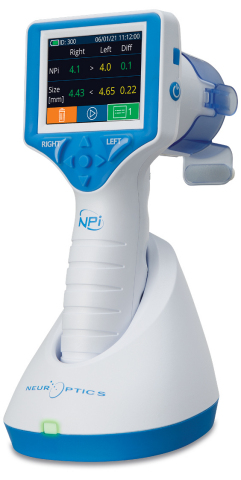IRVINE, Calif.--(BUSINESS WIRE)--NeurOptics, the worldwide leader in the science of pupillometry, today announced the U.S. launch of its NPi®-300, a next-generation automated pupillometer that enhances pupillary assessment to assist in detecting cerebral insult, guiding treatment and informing prognosis for clinicians and their patients.
Early detection of neurological injury is critical for effective and timely diagnosis and treatment.1 NeurOptics’ quantitative automated pupillometer provides a reliable measurement of pupil size and reactivity and tracks changes over time, allowing for earlier intervention for patients with brain injury and those at risk of secondary neurological injury. The NPi-300 Pupillometer supports neurological examination in adult and pediatric patients across a broad spectrum of diagnoses, including traumatic brain injury, stroke, seizure, or other neurological events after cardiac arrest and other medical conditions.
The new NPi-300 Pupillometer includes several enhanced features to improve functionality, including:
- Advanced wireless charging technology, offering improved reliability for the clinician
- Incorporated barcode scanner, allowing clinicians to easily scan a new patient’s ID accurately and instantaneously
- Updated graphical user interface, featuring an easy-to-read LCD touchscreen that enhances the visibility of the results screen
“We are excited to launch this advanced, next-generation pupillometer,” said William Worthen, President and CEO, NeurOptics. “It is a pivotal time for pupillometry, as more hospitals, ICUs and emergency departments are adopting the technology to assess patients for changes in pupillary light reflex—a sign of neurological injury. The NPi-300 Pupillometer, along with the Neurological Pupil index™ (NPi®) scale, provides clinicians with the information needed to make better treatment decisions.”
Automated pupillometry has emerged as an important technology that provides a quantitative measurement of pupil size and reactivity, expressed as the Neurological Pupil index (NPi). NPi values range from 0 to 4.9, with scores under 3 considered abnormal. The NeurOptics NPi-300 Pupillometer eliminates the variability and subjectivity inherent in manual pupillary evaluation (performed using a penlight), providing more accurate, reliable, and objective pupil size and reactivity measurement for this vital component of neurological examinations.1-8
About NeurOptics
Headquartered in Irvine, Calif., NeurOptics is the leader in the science of pupillometry. Driven by a passion to help clinicians improve patient outcomes, NeurOptics develops and markets innovative technology for use in critical care medicine, neurology, neurosurgery, emergency medicine, and research. The NeurOptics’ NPi Pupillometer has been included in more than 70 clinical studies, adopted in over 490 hospitals in the United States, and is represented in more than 27 countries worldwide. For more information, visit www.NeurOptics.com. Follow NeurOptics on Facebook, LinkedIn, and Twitter.
References
- Kerr R, Bacon A, Baker L, et al. Underestimation of pupil size by critical care and neurosurgical nurses. American J of Critical Care. 2016;25(3):213-219.
- Olson D, Fishel M. The use of automated pupillometry in critical care. Critical Care Nursing Clinics North America. 2015;28(2016):101-107.
- Meeker M, Du R, Bacchetti P, et al. Pupil examination: validity and clinical utility of an automated pupillometer. J Neurosci Nurs. 2005;37:34–40. 6.
- Wilson S, Amling J, Floyd S, McNair N. Determining interrater reliability of nurses' assessments of pupillary size and reaction. J Neurosci Nurs. 1988;20:189–192.
- Litvan I, Saposnik G, Mauriño J, et al. Pupillary diameter assessment: need for a graded scale. Neurology. 2000;54:530–531. 25.
- Olson D, Stutzman S, Saju C, Wilson M, Zhao W, Aiyagari V. Interrater reliability of pupillary assessments. Neurocritical Care. 2015. 26.
- Stutzman S, Olson D, Saju C, Wilson M, Aiyagari V. Interrater reliability of pupillar assessments among physicians and nurses. UT Southwestern Medical Center; 2014. 27.
- Worthley L. The pupillary light reflex in the critically ill patient. Critical Care and Resuscitation. 2000;2(7).




